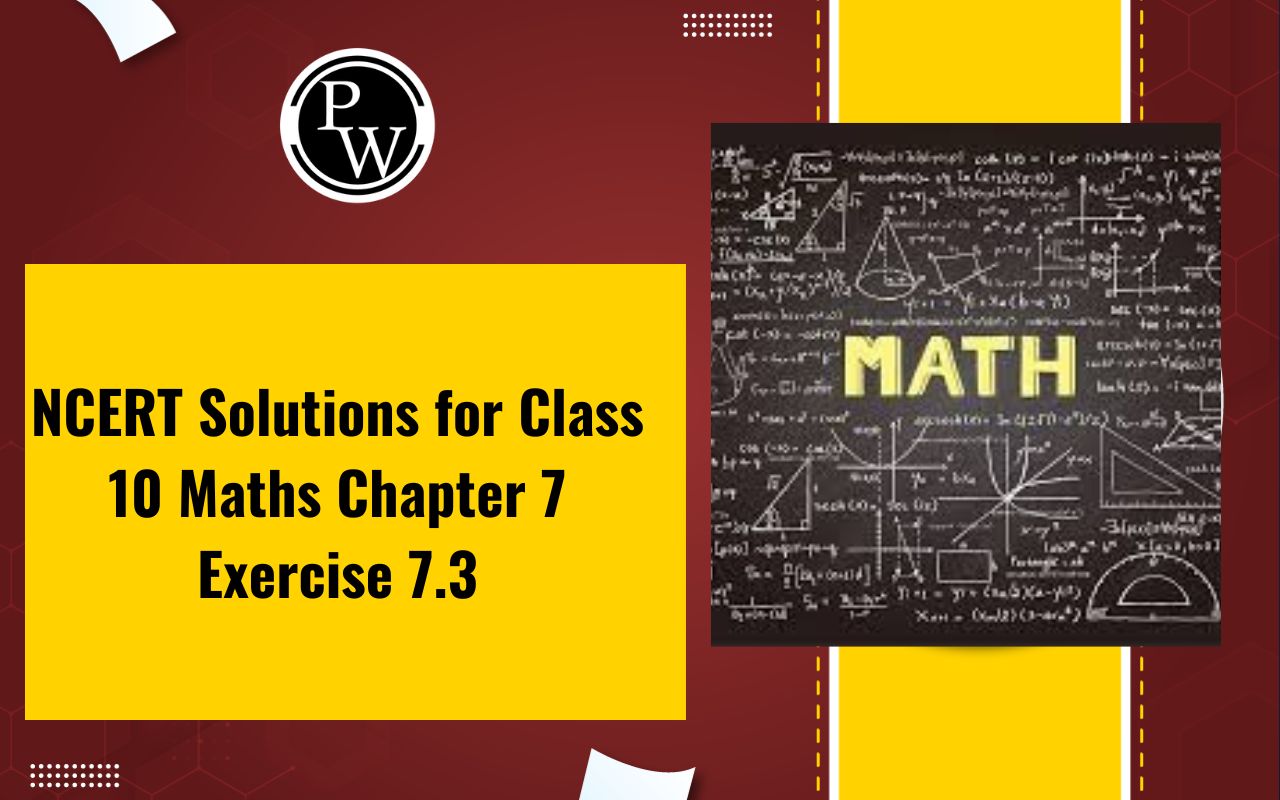

NCERT Solutions for Class 10 Maths Chapter 7 Exercise 7.3: NCERT Solutions for Class 10 Maths Chapter 7 Exercise 7.3 focuses on solving problems related to the distance formula in coordinate geometry.
The questions in this exercise involve applying the formula to find the length of a line segment connecting two given points, strengthening the conceptual understanding of coordinate geometry. By practicing this exercise, students can enhance their problem-solving skills and gain confidence in using the distance formula effectively.CBSE Class 10 Previous Year Question Papers
NCERT Solutions for Class 10 Maths Chapter 7 Exercise 7.3 Overview
NCERT Solutions for Class 10 Maths Chapter 7 Exercise 7.3 is based on the concept of the distance formula in coordinate geometry. The exercise includes problems that require students to calculate the distance between two given points on a Cartesian plane.CBSE Class 10 Maths Sample Paper 2024-25
This exercise helps students strengthen their understanding of how to apply the distance formula in various geometrical scenarios. Through the practice questions, students will learn to find the distance between two points in different coordinate planes, thus improving their grasp on basic coordinate geometry concepts. This exercise is essential for building a solid foundation for more advanced topics in geometry and algebra.NCERT Solutions for Class 10 Maths Chapter 7 Exercise 7.3 PDF
The NCERT Solutions for Class 10 Maths Chapter 7 Exercise 7.3 PDF is available for download below. This exercise focuses on the distance formula in coordinate geometry, where students can practice problems related to finding the distance between two points on the Cartesian plane. You can download the PDF and use it to strengthen your understanding and practice more problems from this chapter.NCERT Solutions for Class 10 Maths Chapter 7 Exercise 7.3 PDF
NCERT Solutions for Class 10 Maths Chapter 7 Coordinate Geometry Exercise 7.3
Below is the NCERT Solutions for Class 10 Maths Chapter 7 Coordinate Geometry Ex 7.3-Solve the following Questions.
1. Find the area of the triangle whose vertices are:(i) (2, 3), (–1, 0), (2, –4)
(ii) (–5, –1), (3, –5), (5, 2)
Answer:
(i) (2, 3), (–1, 0), (2, –4) Area of Triangle is given by Area of Triangle = Area of the given triangle = ½[2 {0 − (−4)} – 1 (−4 − 3) + 2 (3 − 0)]
=½ (8 + 7 + 6) = 21/2 sq. units
(ii) (–5, –1), (3, –5), (5, 2)
Area of the given triangle = ½ [−5 (−5 − 2) + 3 {2 − (−1)} + 5 {−1 − (−5)}]
= ½(35 + 9 + 20)
= 32 sq. units
2. In each of the following find the value of ‘k’, for which the points are collinear.
Area of the given triangle = ½[2 {0 − (−4)} – 1 (−4 − 3) + 2 (3 − 0)]
=½ (8 + 7 + 6) = 21/2 sq. units
(ii) (–5, –1), (3, –5), (5, 2)
Area of the given triangle = ½ [−5 (−5 − 2) + 3 {2 − (−1)} + 5 {−1 − (−5)}]
= ½(35 + 9 + 20)
= 32 sq. units
2. In each of the following find the value of ‘k’, for which the points are collinear.
(i) (7, –2), (5, 1), (3, k)
(ii) (8, 1), (k, –4), (2, –5)
Answer:
(i) (7, –2), (5, 1), (3, k)
Since, the given points are collinear, it means the area of triangle formed by them is equal to zero. Therefore, for points (7, -2) (5, 1), and (3,k), area = 0 ⇒ ½[7 (1 − k) + 5 {k − (−2)} + 3 (−2 − 1)] = ½(7 − 7k + 5k + 10 − 9) = 0 ⇒ ½(7 − 7k + 5k + 1) = 0 ⇒ ½(8 − 2k) = 0 ⇒ 8 − 2k = 0 ⇒ 2k = 8 ⇒ k = 4 (ii) (8, 1), (k, –4), (2, –5) Since, the given points are collinear, it means the area of triangle formed by them is equal to zero. Therefore, for points (8, 1) (k, -4), and (2,-5), area = 0 ⇒ ½[8 {−4 − (−5)} + k (−5 − 1) + 2 {1 − (−4)}] = ½(8 − 6k + 10) = 0 ⇒ ½(18 − 6k) = 0 ⇒18 − 6k = 0 ⇒ 18 = 6k ⇒ k = 3 3. Find the area of the triangle formed by joining the mid–points of the sides of the triangle whose vertices are (0, –1), (2, 1) and (0, 3). Find the ratio of this area to the area of the given triangle.Answer:
 Let the vertices of the triangle be A (0, -1), B (2, 1), C (0, 3).
Let D, E, F be the mid-points of the sides of this triangle. Coordinates of D, E, and F are given by
D = (0+2/2 , -1+1/2) = (1,0)
E = (0+0/2 , -3-1/2) = (0,1)
Area of a triangle = 1/2 {x
1
(y
2
- y
3
) + x
2
(y
3
- y
1
) + x
3
(y
1
- y
2
)}
Area of ΔDEF = 1/2 {1(2-1) + 1(1-0) + 0(0-2)}
= 1/2 (1+1) = 1 square units
Area of ΔABC = 1/2 [0(1-3) + 2{3-(-1)} + 0(-1-1)]
= 1/2 {8} = 4 square units
Therefore, the required ratio is 1:4.
4. Find the area of the quadrilateral whose vertices taken in order are (–4, –2), (–3, –5), (3, –2) and (2, 3).
Let the vertices of the triangle be A (0, -1), B (2, 1), C (0, 3).
Let D, E, F be the mid-points of the sides of this triangle. Coordinates of D, E, and F are given by
D = (0+2/2 , -1+1/2) = (1,0)
E = (0+0/2 , -3-1/2) = (0,1)
Area of a triangle = 1/2 {x
1
(y
2
- y
3
) + x
2
(y
3
- y
1
) + x
3
(y
1
- y
2
)}
Area of ΔDEF = 1/2 {1(2-1) + 1(1-0) + 0(0-2)}
= 1/2 (1+1) = 1 square units
Area of ΔABC = 1/2 [0(1-3) + 2{3-(-1)} + 0(-1-1)]
= 1/2 {8} = 4 square units
Therefore, the required ratio is 1:4.
4. Find the area of the quadrilateral whose vertices taken in order are (–4, –2), (–3, –5), (3, –2) and (2, 3).
Answer:
 Let the vertices of the quadrilateral be A ( - 4, - 2), B ( - 3, - 5), C (3, - 2), and D (2, 3). Join AC to form two triangles ΔABC and ΔACD.
Area of a triangle = 1/2 {x
1
(y
2
- y
3
) + x
2
(y
3
- y
1
) + x
3
(y
1
- y
2
)}
Area of ΔABC =1/2[−4 (−5 − 2) – 3 {-2 − (−2)} + 3 {−2 − (−5)}]
=1/2 [12 + 0 + 9]
= 21/2 sq. units
Again using formula to find area of triangle:
Area of △ACD = [−4 (−2 − 3) + 3 {3 − (−2)} + 2 {−2 − (-2)}]
= 1/2 [20 + 15 + 0]
= 35/2 sq. units
Area of ☐ABCD = Area of ΔABC + Area of ΔACD
= 21/2 + 35/2 = 28 sq. units
5. We know that median of a triangle divides it into two triangles of equal areas. Verify this result for △ABC whose vertices are A (4, –6), B (3, –2) and C (5, 2).
Let the vertices of the quadrilateral be A ( - 4, - 2), B ( - 3, - 5), C (3, - 2), and D (2, 3). Join AC to form two triangles ΔABC and ΔACD.
Area of a triangle = 1/2 {x
1
(y
2
- y
3
) + x
2
(y
3
- y
1
) + x
3
(y
1
- y
2
)}
Area of ΔABC =1/2[−4 (−5 − 2) – 3 {-2 − (−2)} + 3 {−2 − (−5)}]
=1/2 [12 + 0 + 9]
= 21/2 sq. units
Again using formula to find area of triangle:
Area of △ACD = [−4 (−2 − 3) + 3 {3 − (−2)} + 2 {−2 − (-2)}]
= 1/2 [20 + 15 + 0]
= 35/2 sq. units
Area of ☐ABCD = Area of ΔABC + Area of ΔACD
= 21/2 + 35/2 = 28 sq. units
5. We know that median of a triangle divides it into two triangles of equal areas. Verify this result for △ABC whose vertices are A (4, –6), B (3, –2) and C (5, 2).
Answer:
 Let the vertices of the triangle be A (4, -6), B (3, -2), and C (5, 2).
Let D be the mid-point of side BC of ΔABC. Therefore, AD is the median in ΔABC.
Coordinates of point D = (3+5/2, -2+2/2) = (4,0)
Area of a triangle = 1/2 {x
1
(y
2
- y
3
) + x
2
(y
3
- y
1
) + x
3
(y
1
- y
2
)}
Area of △ABD = 1/2[4 (−2 − 0) + 3 {0 − (−6)} + 4 {−6 − (−2)}]
=1/2(−8 + 18 −16)
=1/2 (−6) = −3 sq units
Area cannot be in negative.
Therefore, we just consider its numerical value.
Therefore, area of △ABD = 3 sq units
Again using formula to find area of triangle:
Area of △ABD = 1/2 [4 (0 − 2) + 4{2 − (−6)} + 5 {−6 −0 )}]
= 1/2 (- 8 + 32 −30) = ½ (-6) = -3 sq units.
However, area cannot be negative. Therefore, area of ΔABD is 3 square units.
The area of both sides is same. Thus, median AD has divided ΔABC in two triangles of equal areas
Hence Proved.
Let the vertices of the triangle be A (4, -6), B (3, -2), and C (5, 2).
Let D be the mid-point of side BC of ΔABC. Therefore, AD is the median in ΔABC.
Coordinates of point D = (3+5/2, -2+2/2) = (4,0)
Area of a triangle = 1/2 {x
1
(y
2
- y
3
) + x
2
(y
3
- y
1
) + x
3
(y
1
- y
2
)}
Area of △ABD = 1/2[4 (−2 − 0) + 3 {0 − (−6)} + 4 {−6 − (−2)}]
=1/2(−8 + 18 −16)
=1/2 (−6) = −3 sq units
Area cannot be in negative.
Therefore, we just consider its numerical value.
Therefore, area of △ABD = 3 sq units
Again using formula to find area of triangle:
Area of △ABD = 1/2 [4 (0 − 2) + 4{2 − (−6)} + 5 {−6 −0 )}]
= 1/2 (- 8 + 32 −30) = ½ (-6) = -3 sq units.
However, area cannot be negative. Therefore, area of ΔABD is 3 square units.
The area of both sides is same. Thus, median AD has divided ΔABC in two triangles of equal areas
Hence Proved.
Benefits of Solving NCERT Solutions for Class 10 Maths Chapter 7 Coordinate Geometry Exercise 7.3
Clear Conceptual Understanding : The solutions provide step-by-step explanations of the problems, helping students understand how to apply the distance formula to different coordinate geometry problems. Practice for Exam Preparation : This exercise is created to build students' problem-solving skills. By practicing the questions, students can improve their accuracy and speed, which is important for exams. Boosts Confidence : As students work through the exercises and solve the problems, their confidence increases in handling similar questions in the exams. Strengthens Problem-Solving Skills : By solving various types of problems in this exercise, students enhance their ability to tackle complex geometry questions. Comprehensive Coverage : The solutions cover all important types of questions related to coordinate geometry, ensuring students have a well-rounded understanding of the chapter.NCERT Solutions for Class 10 Maths Chapter 7 Exercise 7.3 FAQs
Why is Exercise 7.3 important for Class 10 Maths?
This exercise is important because it strengthens your understanding of coordinate geometry, particularly how to calculate distances between two points. This concept is widely tested in board exams and other competitive exams.
What are the key concepts covered in Exercise 7.3?
The key concepts covered in this exercise include the distance formula, coordinate geometry, and problem-solving using the distance between two points in a coordinate plane.
How can I practice more problems on distance in coordinate geometry?
To practice more problems, you can refer to additional worksheets or previous year question papers related to coordinate geometry, or consult other reference books for more exercises and solutions.
Is there a shortcut to solve problems in Exercise 7.3?
The best way to solve problems efficiently is by practicing the distance formula and understanding its application. There aren't many shortcuts, but familiarity with the formula and practice will make the process quicker and more accurate.
🔥 Trending Blogs
Talk to a counsellorHave doubts? Our support team will be happy to assist you!

Check out these Related Articles
Free Learning Resources
PW Books
Notes (Class 10-12)
PW Study Materials
Notes (Class 6-9)
Ncert Solutions
Govt Exams
Class 6th to 12th Online Courses
Govt Job Exams Courses
UPSC Coaching
Defence Exam Coaching
Gate Exam Coaching
Other Exams
Know about Physics Wallah
Physics Wallah is an Indian edtech platform that provides accessible & comprehensive learning experiences to students from Class 6th to postgraduate level. We also provide extensive NCERT solutions, sample paper, NEET, JEE Mains, BITSAT previous year papers & more such resources to students. Physics Wallah also caters to over 3.5 million registered students and over 78 lakh+ Youtube subscribers with 4.8 rating on its app.
We Stand Out because
We provide students with intensive courses with India’s qualified & experienced faculties & mentors. PW strives to make the learning experience comprehensive and accessible for students of all sections of society. We believe in empowering every single student who couldn't dream of a good career in engineering and medical field earlier.
Our Key Focus Areas
Physics Wallah's main focus is to make the learning experience as economical as possible for all students. With our affordable courses like Lakshya, Udaan and Arjuna and many others, we have been able to provide a platform for lakhs of aspirants. From providing Chemistry, Maths, Physics formula to giving e-books of eminent authors like RD Sharma, RS Aggarwal and Lakhmir Singh, PW focuses on every single student's need for preparation.
What Makes Us Different
Physics Wallah strives to develop a comprehensive pedagogical structure for students, where they get a state-of-the-art learning experience with study material and resources. Apart from catering students preparing for JEE Mains and NEET, PW also provides study material for each state board like Uttar Pradesh, Bihar, and others
Copyright © 2025 Physicswallah Limited All rights reserved.











